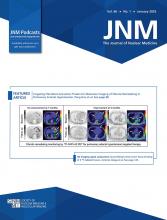Solving challenging puzzles: Heather Jacene, MD, talks about her career as a clinical innovator in nuclear medicine and leadership roles in the SNMMI.
Page 1
Nuclear cardiology surrogate biomarkers: Miller and colleagues highlight key nuclear cardiology surrogate biomarkers, emphasizing the importance of standardized imaging protocols and robust quantitative techniques to ensure accuracy and reproducibility.
Page 4
Imaging the aging brain: Zhong and colleagues provide a brief overview of the current status of PET and multimodality molecular imaging of the aging brain and the ways in which associated elucidation of structural/functional change may guide research.
Page 12
CSC imaging: dos Santos and Witney explore the application of molecular imaging techniques to noninvasive detection of cancer stem cells, providing real-time monitoring with the potential to predict therapy resistance and guide personalized treatment.
Page 14
The case for routine RPT dosimetry: Sunderland looks at barriers to adoption of routine clinical dosimetry for radiopharmaceutical therapy and reports on the results of a survey of current practice in North America.
Page 20
New guidelines in meningiomas: Albert and colleagues summarize recently published joint professional society practice guidelines/procedure standards for diagnosis and therapy of meningiomas using radiolabeled somatostatin receptor ligands.
Page 24
FAP PET guidelines: Hope and members of an SNMMI/European Association of Nuclear Medicine expert group provide procedure standards/practice guidelines for the use of fibroblast activation protein–targeted PET, including indications, procedure specifications, interpretation, documentation, and reporting.
Page 26
[18F]FTT PET of PARP1 in ovarian cancer: Weeks and colleagues compare the efficacy of a PARP1-targeted radiotracer with that of [18F]FDG in tumor features commonly assessed in ovarian cancer and in others not included in current routine analyses.
Page 34
CD137 PET and immunotherapy monitoring: Cheng and colleagues introduce [18F]AlF-NOTA-BCP137, a bicyclic peptide–based probe that targets CD137 for noninvasive PET imaging of tumor-infiltrating activated T cells, with promise for monitoring multiple combination immunotherapies.
Page 40
Analyzing 177Lu-PSMA-617 therapy criteria: Demirci and colleagues evaluate associations between TheraP trial eligibility criteria and treatment outcomes of patients who were deemed suitable for and treated on the basis of VISION trial criteria.
Page 47
Volume criteria in PSMA PET: Unterrainer and colleagues detail the results of a multicenter study comparing conventional imaging–based disease volume criteria with those of PSMA PET in a cohort of patients with metastatic hormone-sensitive prostate cancer.
Page 54
177Lu-PSMA RLT versus cabazitaxel: Wenzel and colleagues compare progression-free and overall survival in clinical experience with patients with metastatic castration-resistant prostate cancer treated with 177Lu-vipivotide tetraxetan-PSMA, cabazitaxel chemotherapy, or both.
Page 61
Pattern of metastases after PSMA RGS: Schweiger and colleagues use PSMA-ligand PET to evaluate patterns of biochemical failure, including early recurrent disease, in patients with prostate cancer after PSMA-radioguided surgery.
Page 67
Biochemical recurrence and PSMA: Delgado Bolton offers perspective on diagnostic and therapeutic nuclear medicine procedures using PSMA radiopharmaceuticals, providing context for an article in this issue of JNM and emphasizing the importance of multidisciplinary collaboration.
Page 73
PSMA PET staging and positivity: Miller and colleagues report on the use of PSMA-based PET staging for newly diagnosed prostate cancer in the Veterans Health Administration from 2020 to 2023, focusing on patterns and rates of positive PET findings.
Page 75
Tumor growth model for [177Lu]Lu-PSMA: Zaid and colleagues develop and apply a mathematic model to test the hypothesis that current treatment and scheduling regimens for [177Lu]Lu-PSMA therapy are suboptimal.
Page 84
Prodrug activation using radionuclides: Quintana and colleagues research whether a strategy of radionuclide-induced drug engagement for release can locally deliver combined radiation and chemotherapy to maximize tumor cytotoxicity while minimizing off-target exposure to activated chemotherapy agents.
Page 91
18F-FAPI PET and PAH: Hou and colleagues investigate in a rat model the feasibility of using 18F-labeled fibroblast activation protein inhibitor PET/CT to assess fibrotic remodeling of the pulmonary artery and right ventricle in pulmonary arterial hypertension.
Page 98
99mTc-Technegas versus 133Xe: Parihar and colleagues compare the quantification of relative lung ventilation with 99mTc-Technegas with that performed using the standard approach with inhaled 133Xe in data from pre–lung transplant patients.
Page 104
Clinical value of Aβ PET quantification: Collij and members of the multinational AMYPAD Consortium report on an analysis of their data on correlations between quantification and visual assessment of amyloid-β PET images, pointing to potential enhancement of future treatment decisions.
Page 110
Quantitation of COX-1 in human brain: Ghazanfari and colleagues quantify the specific binding of [11C]PS13 to cyclooxygenase-1 in healthy human brains using PET performed with arterial input function at baseline and after blockade by the COX-1–selective inhibitor ketoprofen.
Page 117
Comparison of tau PET imaging agents: Aliaga and colleagues perform head-to-head comparisons of the in vitro binding properties of [18F]flortaucipir, [18F]MK6240, and [18F]PI2620 in postmortem human brain tissue from controls and individuals with Alzheimer disease.
Page 123
Imaging misfolded SOD1: Rousseau and colleagues detail preclinical development of [89Zr]Zr-desferoxamine-α-miSOD1, a PET agent targeting selectively misfolded superoxide dismutase 1, a common cause of amyotrophic lateral sclerosis.
Page 130
Spinal cord myelin PET: van der Weijden and colleagues present a translational study evaluating [11C]N-methyl-4,4′-diaminostilbene as a PET tracer for myelin imaging in the rat and human spinal cords, demonstrating the potential to quantify myelin density.
Page 136
Acute hypoxia and A1AR availability: Michno and colleagues use [18F]CPFPX), a PET tracer for the A1 adenosine receptor, to determine whether hypoxia-induced adenosine release reduces A1AR availability in human brain and is associated with altered brain perfusion and psychomotor vigilance.
Page 142
Quantitative accuracy of the NeuroEXPLORER: Omidvari and colleagues assess the quantitative precision of this recently developed dedicated brain PET system, using phantom and human data imaging conditions relevant to dynamic neuroimaging studies.
Page 150
SNMMI General Nuclear Medicine Highlights: Bartel summarizes selected noteworthy presentations in general nuclear medicine and molecular imaging from the 2024 SNMMI Annual Meeting.
Page 158
Extracranial PET staging for high-grade meningiomas: Ermiş and colleagues ask whether whole-body staging with [68Ga]Ga-DOTATOC PET/CT for high-grade meningiomas should become standard clinical practice.
Page 162
- © 2025 by the Society of Nuclear Medicine and Molecular Imaging.







